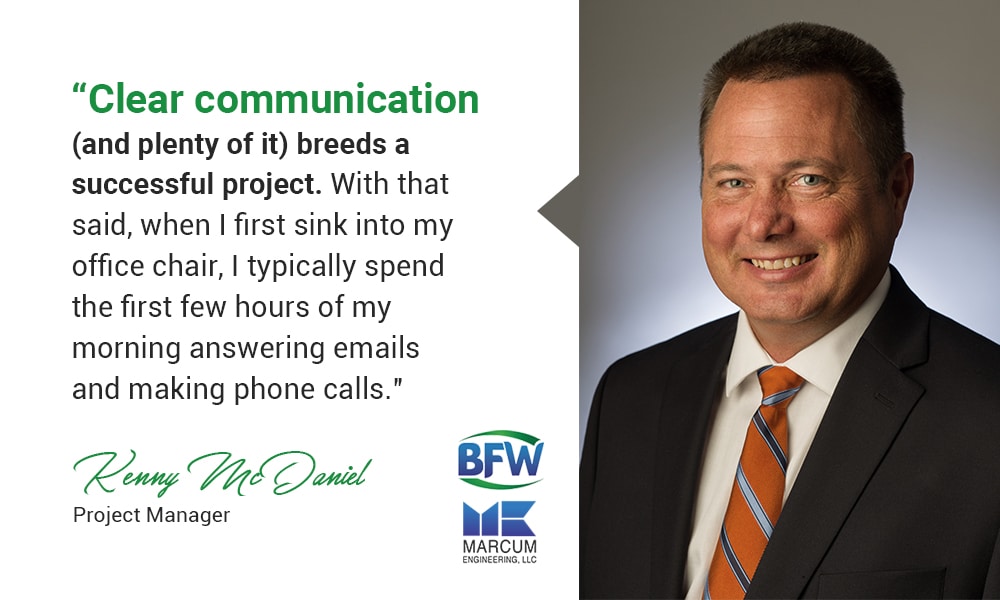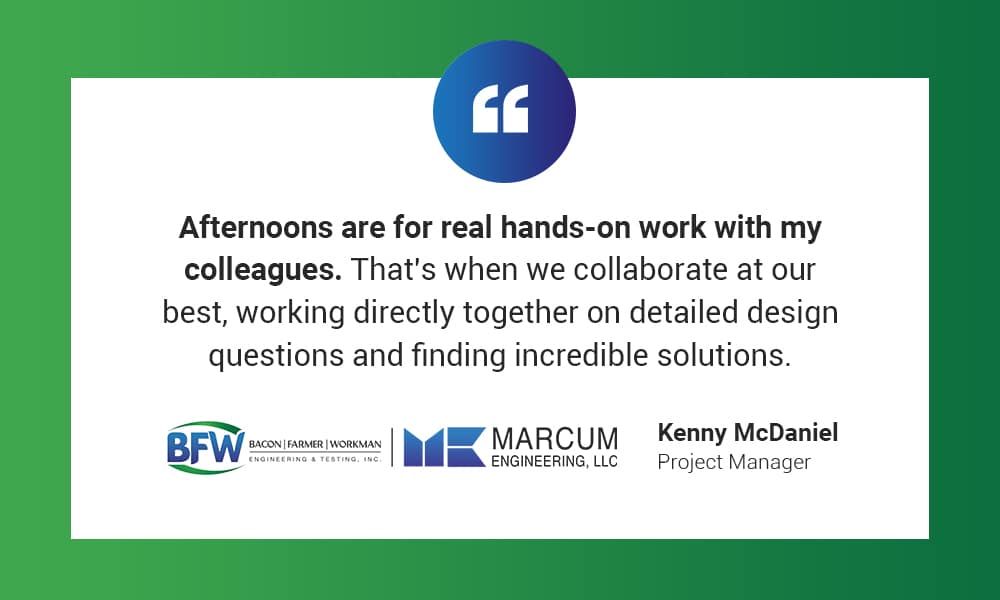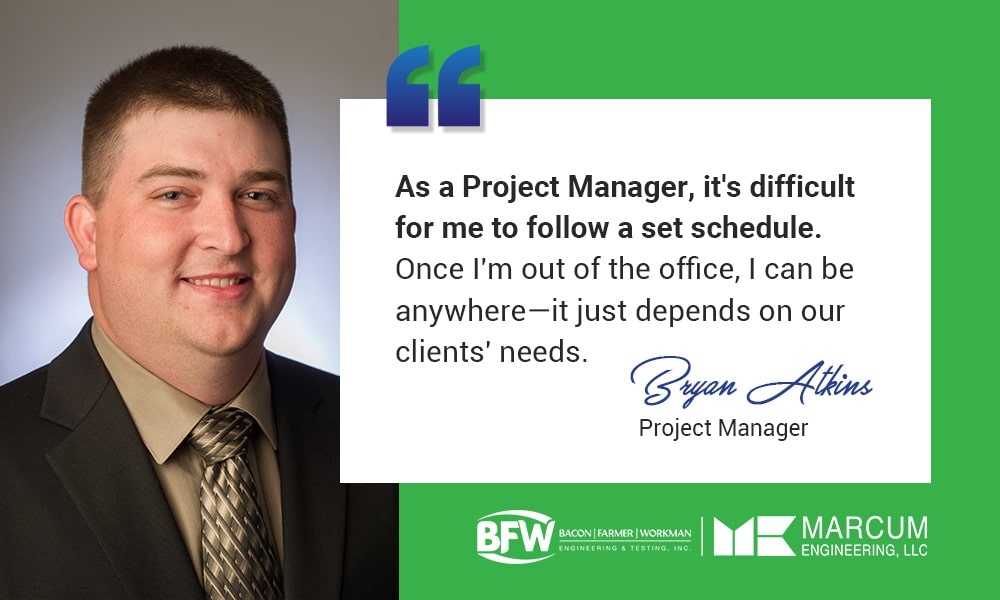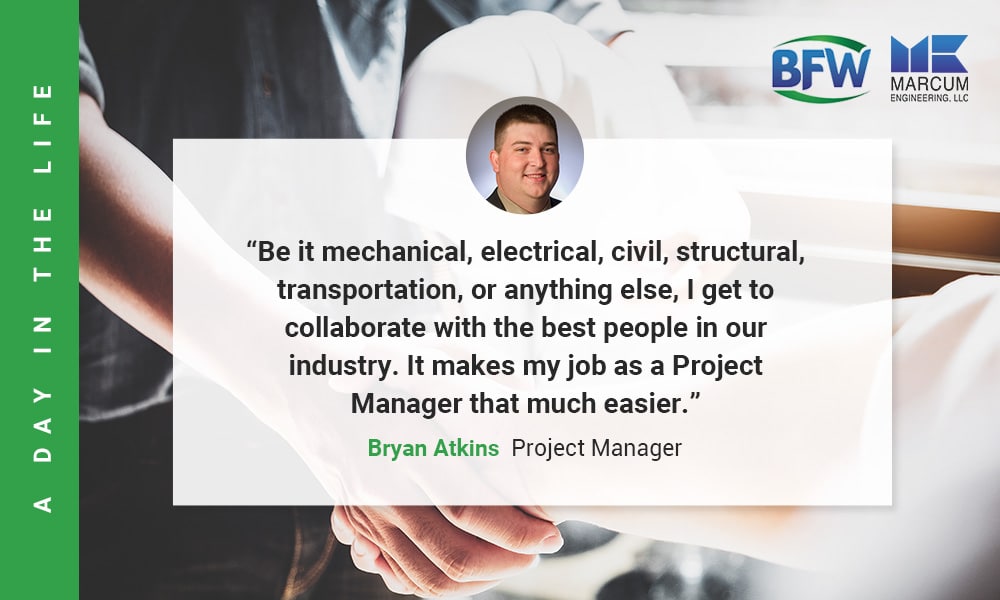You take the good with the bad. Even if you didn’t grow up on seventies-era television, you understand that those are the facts of life. Being an engineer is no different—your day is filled with highs and lows, both equally thrilling in their own right. Yet, the question is often asked: What does an average day for an engineer look like? What obstacles must they navigate? Whether it’s commuter traffic, making the perfect pot of coffee, or being a rock star to clients, an engineer will always find clever solutions to life’s problems. That’s why we asked two of our top engineers, Kenny McDaniel and Bryan Atkins, to share a day in the life as an engineer.
Kenny McDaniel, Project Manager
Kenny’s one of the best engineers at BFW/Marcum. He’s also a family man, so he carefully balances his work and home life in any way necessary.
Morning
My typical morning starts well before the rest of the firm arrives. I like to give myself at least an hour to plan the day, typically during my hour commute to work. Of course, Mike Tyson has a great quote that applies even outside the ring and into the engineering world.
“Everybody’s got a plan till they get punched in the face.”
What I mean to say is that the idealism of the quiet early morning in my car driving to work versus the first ten minutes at my desk have strikingly different realities. But as an engineer, the first thing you do in your profession is to learn how to adapt and react.
Not to mention, during these thought exercises in my car, I happen to commute through one of the heaviest white-tail deer populations in the region. So, through practice, I’ve learned the tenants of multitasking while simultaneously avoiding disaster. If anyone’s been in the field as an engineer, they know the advantage that skill brings! While my track record on the road leaves a bit to be desired (I’m infamous for having the most deer and car incidents in the entire office), my engineering record is impeccable—if only deer would move at the same speed as red tape.
Mid-to-Late-Morning (in the Office)
Anyone in the industry knows that engineering isn’t just about rolling up your sleeves and getting dirty. There’s a lot of communication and collaboration involved. Sometimes, that’s the largest portion of my job. Clear communication (and plenty of it) breeds a successful project. With that said, when I first sink into my office chair, I typically spend the first few hours of my morning answering emails and making phone calls.
Lunch Time
Noon rolls around almost immediately after I finish with my morning correspondence. Depending on my workload for the day, I’ll rotate between lunch at my desk, a quiet, introspective lunch by myself away from the office, or a bigger, more entertaining lunch with my colleagues.
I’ve learned that part of having a good team is nurturing it. So, we all try to have lunch together when possible, and we try to talk about the home life, try (and fail) to discuss politics, and more-or-less try to keep the conversation light and fun. Nothing relieves stress like talking to your coworkers like people rather than colleagues—it’s a subtle difference, but it’s important.
Afternoon
Most days, lunch leaves me feeling refreshed, and I’ve typically finished a lot of the paper-pushing, day-to-day administration stuff in the morning. Afternoons are for real hands-on work with my colleagues. That’s when we collaborate at our best, working directly together on detailed design questions and finding incredible solutions.
You’d be surprised what you can accomplish when you work together, throw away your expectations, and apply your knowledge and expertise to a problem. When you’re working with the best people in the industry, problems are fun challenges, and the solutions sometimes surprise even us. You know you’re working well together when you’re constantly impressed with your product. I love that part of my job here at BFW/Marcum.
Evening
Because I arrive early, I can usually head out of the office right as we’re closing. Anyone who’s an engineer knows that long hours are normal; the kind of work we do can’t always be put on pause for the next day—not if you’re going to go above and beyond for your clients.
I take the hour commute home to reset my perspective. I try to exit “supervisor-mode” and enter “husband and dad-mode.” I’ve learned long ago that neither my wife or children appreciate, accommodate, or even occasionally humor my management expertise. So to minimize hurt feelings (mine) and tears (also mine), I disregard that part of me and come home as a dad and husband. My kids are very active in sports, so much of the time is spent at various games, which my wife and I divvy up as we see fit. I’m also a basketball coach, so there are certain games I can’t miss, and I’m totally alright with that commitment.
My career as an engineer and my time as a family man have a lot in common, even if I try to separate the two. Both roles require solutions, but they also teach you to listen. Sometimes, the solution is as simple as hearing someone out and letting the dust settle. It’s valuable advice that you often learn the hard way.
Bryan Atkins, Project Manager
We wouldn’t call Bryan the most jaded employee at BFW/Marcum, but we’ve grown to appreciate his to-the-point candor. Bryan’s the kind of engineer who has a thorough understanding of the rules but isn’t afraid to question something he doesn’t agree with. With only a small amount of trepidation, we asked Bryan about his average day.
Morning
My day starts with a forty-minute drive to the office. I’ve grown used to the two most prevalent features riddling the landscape of that early-morning commute: fools and morons. I categorize fools as the types of people who drive too slowly in the left lane. On the other hand, morons are the people flying by me going way too fast. Of course, I’m the only guy on the road with exceptional driving.
Mid-to-late Morning
I’d like to say I start my day promptly and finish my morning routine as efficiently as possible so I can dive into the work that is more relevant to my engineering degree. However, most days (every day) are filled with run-of-the-mill interruptions, like meetings, passersby, and unorthodox requests from BFW/Marcum’s marketing team, like that time they asked me to write a story about my day.
Afternoon
As a Project Manager, it’s difficult for me to follow a set schedule. Once I’m out of the office, I can be anywhere—it just depends on our clients’ needs. Lunches can be had in the car, at a restaurant with a client, or my desk when I have some work to do.
Project Managers are the unequivocal face of any given project. We’re the people our clients most often see, so I must be where they need me. My goal is to exceed expectations, so that often means my days are dynamic and each is different.
Even when I’m working with the same clients, even when we’re engineering a building we’ve already done for them in the past, things will change. Anywhere you go, the environment is different down to the type of soil. Many things need to be adapted on-the-go, but the one thing that is consistent about my job is the great minds I get to work with.
Be it mechanical, electrical, civil, structural, transportation, or anything else, I get to collaborate with the best people in our industry. It makes my job as a Project Manager that much easier.
When I’m not in the field, I’m usually in a meeting, both internal and client-facing. A huge part of my job involves juggling the management side of the firm. Some days, I have meetings all day. Yet, we get calls and emails that need timely attention, sometimes while I’m in a meeting. Did I mention that BFW/Marcum really likes a good meeting? It’s okay, though—I’ve learned that to succeed in this industry, every single person needs to be on the same page, from the tenant to the financers. That requires a lot of conversations.
Evening
Finally, after many of my colleagues go home for the day, I can get some of my own work done. I find that most of my workload completion occurs either before 7 am or after 5 pm. Much of the time, I stay after 5 pm to get work done without interruption.
Since I have my hand in a few layers of our process, we use both CAD and Revit and help our design staff with project layouts. For many of our calculations, we use old-fashioned Excel. From that seemingly simple program, you can size water piping, calculate water heater demands, and even extrapolate the amount of ventilation air required for a certain space. If you know what you’re doing, Excel is like those antique computers NASA had in their rockets—it’ll take you to the moon and back.
We use modeling software to determine the HVAC system load to properly select equipment to maintain occupant comfort. We attend meetings on the projects that are in construction and complete a walk-through to observe how the construction is progressing and that it is being installed according to the plans and specs that we designed. We attend training on various subjects to stay up to date on new technologies, new codes, new equipment offerings to ensure that we can provide our clients with the most up to date information to make informed decisions about their project.
All-in-all, I love my job. As a Project Manager, I’m the guy who has to drive the project perfectly. The figurative car needs to be in the correct lane and going at the right speed. If someone’s going too slow, or they’re flying by at the seat of their pants, it’s my job to correct that behavior and get things moving again at the right pace. At BFW/Marcum, I have the room to do that, and I have some of the best people in the industry driving alongside me.





Recent Comments